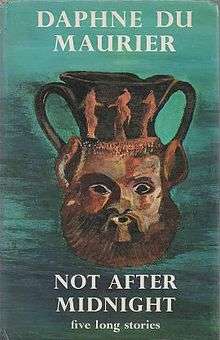Not After Midnight
 First edition | |
| Author | Daphne Du Maurier |
|---|---|
| Cover artist | Flavia Tower[1] |
| Country | United Kingdom |
| Language | English |
| Publisher | Victor Gollancz |
Publication date | 1971 |
| Media type | |
| Pages | 284 |
| ISBN | 0-575-00765-6 |
Not After Midnight is a 1971 collection of short stories by Daphne du Maurier. It was published in Britain under the title Not After Midnight by Gollancz (with a cover by Daphne du Maurier's daughter Flavia Tower[1][2]), and published in America by Doubleday as Don't Look Now. The book contains several novella-length stories, all with different characters and themes but similar in that they touch on the supernatural or strange events. The Penguin Books edition, Harmondsworth and Ringwood, Victoria, Australia, was issued with the title Don't Look Now and Other Stories and a cover illustration by Charles Raymond in 1973.[3]
Don't Look Now
John and his grief-stricken wife Laura take a holiday in Venice following the death of their daughter, Christine, from meningitis. They encounter middle-aged identical twin sisters, one of whom is blind and claims to be psychic and that she can 'see' Christine sitting with her parents. Meanwhile, Venice has been plagued by a series of murders and during a night out John briefly spots what appears to be a small girl wearing a pixie-hood leaping across some moored boats and almost falling into the water before disappearing into one of the houses along the canal. They also run into the sisters again at the restaurant they are dining in; they tell Laura that Christine is trying to warn them that they are in danger if they remain in Venice, and that John also has the gift of second sight but does not realise it. On arriving back at their hotel a message has been left for them by the headmaster of their son's preparatory school informing them that their son, Johnnie, has been taken ill with appendicitis. Laura immediately books a flight back to England but later in the day John is convinced he has seen her on a vaporetto with the sisters. Unable to locate Laura or the sisters he reports her disappearance to the police. Upon his return to the hotel, John decides to call his son's school to check up on Johnnie and is astounded to find that Laura is in fact in England after all. Meanwhile, the sisters have been arrested and are being held in police custody so John makes his way to the police station to sort out the mix-up. He escorts the sisters back to their pension, but upon arrival the psychic sister falls into a trance. John leaves hurriedly and, disoriented, stumbles upon the alley from the previous evening. Once again, he catches sight of the pixie-hood wearing childlike figure leaping across moored boats, but this time he sees a man in pursuit. Horrified that the man is the murderer terrorising Venice chasing his next victim, he follows her into a room she has run to and proceeds to bolt the door shut to keep out the assailant. As the pixie-hood drops to the floor, the 'child' is revealed to not be a little girl at all, but a middle-aged female dwarf. Grinning, the dwarf pulls a knife from her pocket and throws it at John, piercing his throat. As John slumps to the floor, he has a vision of Laura on the vaporetto with the sisters, and this time realises it is a premonition of his funeral.
The story has been adapted in several mediums: a classic 1973 film directed by Nicolas Roeg; a radio adaptation by Ronald Frame, first broadcast 9 December 2001 on BBC Radio 4 as part of the Classic Serial series; and a stage play by Nell Leyshon in 2007.
Other stories
- "Not After Midnight" is a tale about a lonely teacher who goes on a painting holiday in Crete and meets a strange American couple. The woman invites him to visit them in their hotel room but "not after midnight," the reason for this becoming clear as the story progresses. Set in and around Agios Nikolaos on Crete.
- "The Breakthrough" is a science fiction story set in an isolated laboratory in the wilds of Norfolk. A man is sent to help with a new computer. He soon realises that the purpose of the scientific experiments being conducted there is to trap the life force, or soul, at the point of death and utilise its energy. The test subject is Ken, an affable young assistant who is dying of leukemia. The plan goes horribly awry.
- In "The Way of the Cross", a disparate group of pilgrims from the same village embark on a trip to frenetic, dusty Jerusalem. Their regular vicar is taken ill and replaced by The Reverend Babcock, a rough diamond from Leeds. On the first night young Robin, a precocious nine-year-old, suggests a walk to the Garden of Gethsemane. In the dark, among the bushes and trees, two people overhear things about themselves that force them to re-evaluate their lives. Subsequently, the whole group learn a great deal about themselves and their loved ones, and return home better people.
- In "A Border Line Case", a young actress pursues old family friend Nick after the death of her father. She discovers he is an IRA commander and accompanies him on a bombing raid in Ireland, but soon learns that he is not all he seems to be.
References
- 1 2 SF Encyclopedia Picture Gallery Retrieved 2013-08-04
- ↑ Who is Flavia Tower? Retrieved 2013-08-04.
- ↑ Penguin Book 3590; ISBN 0-14-003590-7